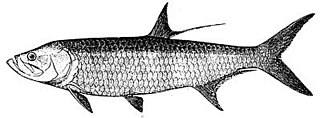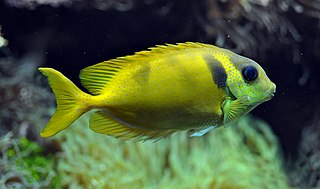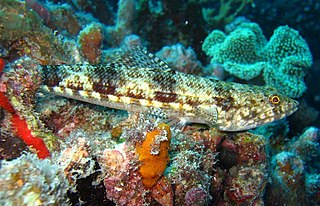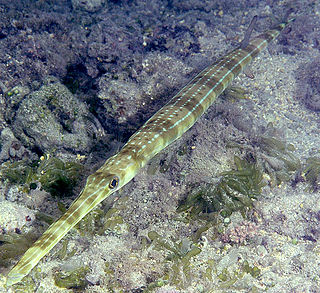The Percopsiformes are a small order of freshwater teleost fishes measuring less than 20 cm in length, comprising the trout-perch and its allies. It contains just ten extant species, grouped into seven genera and three families. Five of these genera are monotypic.

Salmonidae is a family of ray-finned fish that constitutes the only currently extant family in the order Salmoniformes, consisting of 11 extant genera and over 200 species collectively known as "salmonids" or "salmonoids". The family includes salmon, trout, char, graylings, freshwater whitefishes, taimens and lenoks, all coldwater mid-level predatory fish that inhabit the subarctic and cool temperate waters of the Northern Hemisphere. The Atlantic salmon, whose Latin name became that of its genus Salmo, is also the eponym of the family and order names.

The Amblyopsidae are a fish family commonly referred to as cavefish, blindfish, or swampfish. They are small freshwater fish found in the dark environments of caves, springs and swamps in the eastern half of the United States. Like other troglobites, most amblyopsids exhibit adaptations to these dark environments, including the lack of functional eyes and the absence of pigmentation. More than 200 species of cavefishes are known, but only six of these are in the family Amblyopsidae. One of these, Forbesichthys agassizii, spends time both underground and aboveground. A seventh species in this family, Chologaster cornuta, is not a cave-dweller but lives in aboveground swamps.

Characiformes is an order of ray-finned fish, comprising the characins and their allies. Grouped in 18 recognized families, more than 2000 different species are described, including the well-known piranha and tetras.

The Gymnotiformes are an order of teleost bony fishes commonly known as Neotropical knifefish or South American knifefish. They have long bodies and swim using undulations of their elongated anal fin. Found almost exclusively in fresh water, these mostly nocturnal fish are capable of producing electric fields to detect prey, for navigation, communication, and, in the case of the electric eel, attack and defense. A few species are familiar to the aquarium trade, such as the black ghost knifefish, the glass knifefish, and the banded knifefish.
Ophidiiformes is an order of ray-finned fish that includes the cusk-eels, pearlfishes, viviparous brotulas, and others. Members of this order have small heads and long slender bodies. They have either smooth scales or no scales, a long dorsal fin and an anal fin that typically runs into the caudal fin. They mostly come from the tropics and subtropics, and live in both freshwater and marine habitats, including abyssal depths. They have adopted a range of feeding methods and lifestyles, including parasitism. The majority are egg-laying, but some are viviparous.

The Elopiformes are the order of ray-finned fish including the tarpons, tenpounders, and ladyfish, as well as a number of extinct types. They have a long fossil record, easily distinguished from other fishes by the presence of an additional set of bones in the throat.

Arowanas are freshwater bony fish of the subfamily Osteoglossinae, also known as bony tongues. In this family of fish, the head is bony and the elongated body is covered by large, heavy scales, with a mosaic pattern of canals. The dorsal and anal fins have soft rays and are long based, while the pectoral and ventral fins are small. The name "bonytongues" is derived from a toothed bone on the floor of the mouth, the "tongue", equipped with teeth that bite against teeth on the roof of the mouth. The arowana is a facultative air breather and can obtain oxygen from air by sucking it into its swim bladder, which is lined with capillaries like lung tissue.

Neopterygii is a subclass of ray-finned fish (Actinopterygii). Neopterygii includes the Holostei and the Teleostei, of which the latter comprise the vast majority of extant fishes, and over half of all living vertebrate species. While living holosteans include only freshwater taxa, teleosts are diverse in both freshwater and marine environments. Many new species of teleosts are scientifically described each year.

Aulopiformes is a diverse order of marine ray-finned fish consisting of some 15 extant and several prehistoric families with about 45 genera and over 230 species. The common names grinners, lizardfishes and allies, or aulopiforms are sometimes used for this group. The scientific name means "Aulopus-shaped", from Aulopus + the standard fish order suffix "-formes". It ultimately derives from Ancient Greek aulós + Latin forma, the former in reference to the elongated shape of many aulopiforms.

The Gonostomatidae are a family of mesopelagic marine fish, commonly named bristlemouths, lightfishes, or anglemouths. It is a relatively small family, containing only eight known genera and 32 species. However, bristlemouths make up for their lack of diversity with relative abundance, numbering in the hundreds of trillions to quadrillions. The genus Cyclothone is thought to be one of the most abundant vertebrate genera in the world.

Oncorhynchus is a genus of ray-finned fish in the subfamily Salmoninae of the family Salmonidae, native to coldwater tributaries of the North Pacific basin. The genus contains twelve extant species, namely six species of Pacific salmon and six species of Pacific trout, all of which are migratory mid-level predatory fish that display natal homing and semelparity.

Holocentridae is a family of ray-finned fish, the only family of the order Holocentriformes. The members of the subfamily Holocentrinae are typically known as squirrelfish, while the members of Myripristinae typically are known as soldierfish. In Hawaii, they are known by the Japanese name mempachi/menpachi (メンパチ) or the Hawaiian ʻūʻū.

The cornetfishes or flutemouths are a small family, the Fistulariidae, of extremely elongated fishes in the order Syngnathiformes. The family consists of a single genus, Fistularia, with four species, found worldwide in tropical and subtropical marine environments.

Enoplosus armatus, commonly referred to as the old wife, is a species of perciform fish endemic to the temperate coastal waters of Australia. It is the only modern species in the family Enoplosidae.

Eels are ray-finned fish belonging to the order Anguilliformes, which consists of eight suborders, 20 families, 164 genera, and about 1000 species. Eels undergo considerable development from the early larval stage to the eventual adult stage and are usually predators.

Libotonius is an extinct genus of prehistoric percopsiform in the monotypic family Libotoniidae which lived during the middle division of the Eocene epoch. The type species Libotonius blakeburnensis is named for Blakeburn, British Columbia, the type locality of the genus and species in the Allenby Formation. The second species, Libotonius pearsoni is known exclusively from the Klondike Mountain Formation in Republic, Washington.

An anchovy is a small, common forage fish of the family Engraulidae. Most species are found in marine waters, but several will enter brackish water, and some in South America are restricted to fresh water.

Fish are very diverse animals and can be categorised in many ways. Although most fish species have probably been discovered and described, about 250 new ones are still discovered every year. According to FishBase about 34,800 species of fish had been described as of February 2022, which is more than the combined total of all other vertebrate species: mammals, amphibians, reptiles and birds.

Percopsis omiscomaycus, also known as the trout-perch, the grounder or the sand minnow, is one of two species in the family Percopsidae. Its name comes from the Greek root words perc, meaning perch and opsi meaning appearance. The species name omiscomaycus is thought to be derived from a Native American word meaning trout. These are freshwater fish that prefer clear to slightly turbid water, and are found in rivers and lakes throughout North America. They are a generally small fish found in deep waters by day, but which migrate to shallower waters at night.They are most often seen washed up on beaches and are rarely seen alive or correctly identified. The trout-perch possess characteristics similar to both the trout and the perch. They are an important source of food for many predator fish such as walleye, northern pike, and lake trout. They are not a major human fishery, but are occasionally used as a bait fish.



















